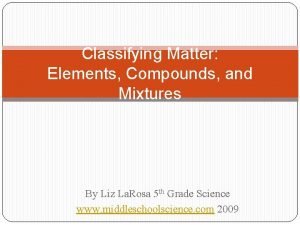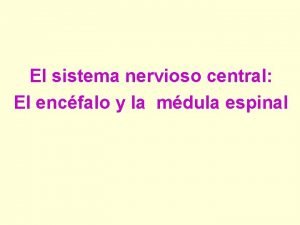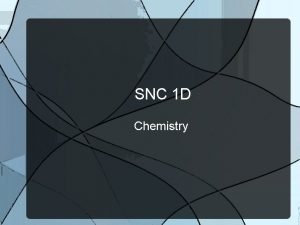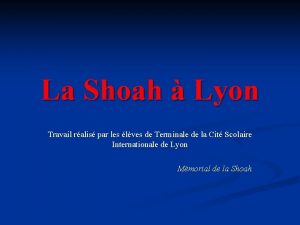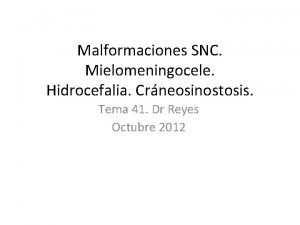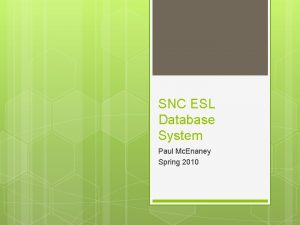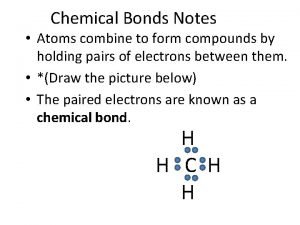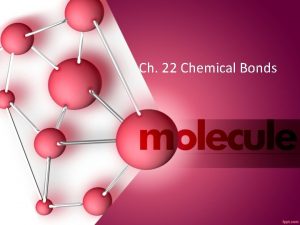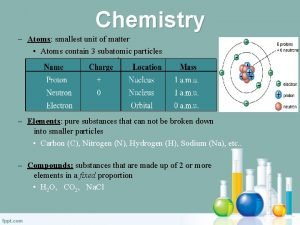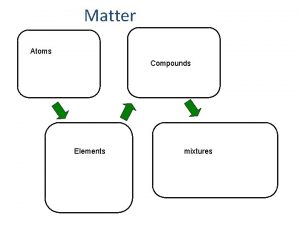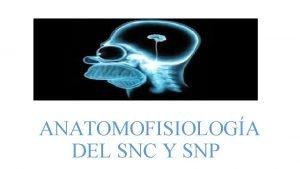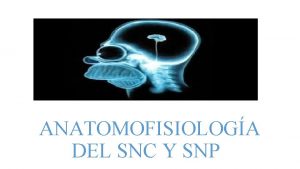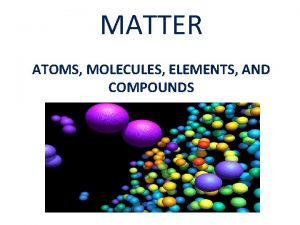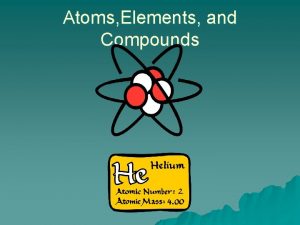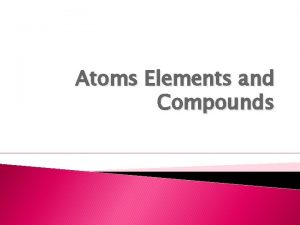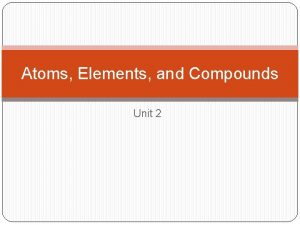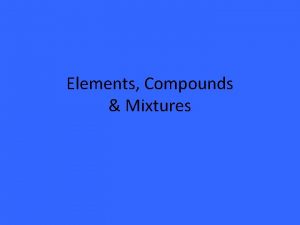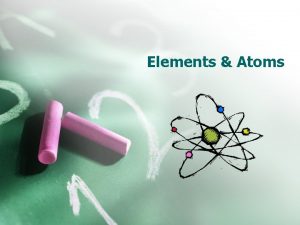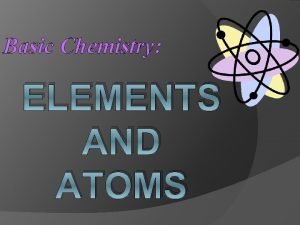SNC 1 D CHEMISTRY ATOMS ELEMENTS COMPOUNDS Matter
















- Slides: 16

SNC 1 D CHEMISTRY ATOMS, ELEMENTS, & COMPOUNDS � Matter (P. 136 -140)

Matter Fireworks are an ancient technology, first invented in China over 2000 years ago. Today, fireworks can be seen around the world and creating them is an art form called pyrotechnics. Pyrotechnics is a branch of chemistry, the science concerned with understanding and changing matter. December 31, 2021 1 DCHEM - Matter 1

Matter is anything that has mass and volume. Matter can be solid, liquid, or gas or a combination of these states. For example, foam is a mixture of a liquid and a gas, or a solid and a gas. MATTER v anything that has mass and volume v can be a solid, liquid, or gas (or a combo of …) December 31, 2021 1 DCHEM - Matter 2

Matter Mass is a measure of the quantity of matter in an object. Mass is often measured in kilograms (kg) or in grams (g). MASS v measure of the quantity of matter in an object v measured in ‘kg’ or ‘g’ December 31, 2021 1 DCHEM - Matter 3

Matter Volume is a measure of how big an object is or how much space a fluid takes up. Volume is often measured in litres (L) or in millilitres (m. L). VOLUME v measure of how much space an object or fluid takes up v measured in ‘L’ or ‘m. L’ NOTE! 1 cm 3 = 1 m. L December 31, 2021 1 DCHEM - Matter 4

The Particle Theory of Matter All matter is made of tiny particles. Different kinds of matter are made of different kinds of particles. For example, the particles that make up water are different from the particles that make up the glass containing it. The particle theory of matter is a way to describe the structure of matter and its behaviour. PARTICLE THEORY OF MATTER v theory that describes the composition and behaviour of matter December 31, 2021 1 DCHEM - Matter 5

The Particle Theory of Matter According to the particle theory: • particles are attracted to each other and are always moving • when heated, particles gain energy and begin to move faster • the distances between the particles change for different states of matter • the amount of attraction is different for different kinds of particles December 31, 2021 1 DCHEM - Matter 6

The Particle Theory of Matter PARTICLE THEORY OF MATTER � All matter is made up of tiny particles (atoms). � All particles have empty spaces between them. � Different substances are made up of different kinds of particles. � Particles are in motion and move faster as temperature increases. � Particles attract each other. December 31, 2021 1 DCHEM - Matter 7

The Particle Theory of Matter PRACTICE 1. Use the diagram below to complete following chart. solid liquid gas force space December 31, 2021 1 DCHEM - Matter 8

Particles & Heat NOTE! For a given substance, such as water, the state it is in is related to its temperature. As heat (energy) is added, the particles vibrate more quickly, which weakens the attraction between them. December 31, 2021 1 DCHEM - Matter 9

Particles & Heat PRACTICE 2. Water can exist as ice, liquid water, or gas. In each of the following, is heat added (+) or removed (–) in order to change the state of water? (a) evaporation + (b) condensation – (c) freezing – (d) melting + December 31, 2021 1 DCHEM - Matter 10

Particles & Heat PRACTICE 3. If you put olive oil in the fridge, the oil becomes solid. Explain what has happened using the particle theory of matter. since heat was removed the particles slowed down December 31, 2021 1 DCHEM - Matter 11

Particles & Heat PRACTICE 4. Tin is a metal with a melting point of 232� C and a boiling point of 2602� C. What is its state of matter at each of the following temperatures? (a) 0� C solid (b) 1000� C liquid (c) 2000� C liquid (d) 4000� C gas December 31, 2021 1 DCHEM - Matter 12

Particles & Heat PRACTICE 5. The melting point of aluminum metal is 660� C. Is its freezing point slightly less than, equal to, or slightly more than 660� C? the freezing point is equal to 660� C (i. e. the transition temperature) December 31, 2021 1 DCHEM - Matter 13

Particles & Heat PRACTICE 6. According to the particle theory of matter, gases contain particles that are far apart. Do the particles in a solid have spaces between them? Are the particles moving? Explain. yes there are spaces and yes the particles are vibrating, but they are vibrating very slowly December 31, 2021 1 DCHEM - Matter 14

�Check Your Learning TEXTBOOK P. 147 Q. 1 -3, 5, 6, 10 December 31, 2021 1 DCHEM - Matter 15
 Study jams mixtures
Study jams mixtures Chemistry in biology section 2 chemical reactions
Chemistry in biology section 2 chemical reactions Chapter 6 section 1 atoms elements and compounds answer key
Chapter 6 section 1 atoms elements and compounds answer key Chapter 6 section 1 atoms elements and compounds
Chapter 6 section 1 atoms elements and compounds Classifying elements compounds and mixtures
Classifying elements compounds and mixtures Periodic table regents
Periodic table regents Hpps logo
Hpps logo Rombencefalo
Rombencefalo Snc1d chemistry
Snc1d chemistry Snc lajaa venissieux
Snc lajaa venissieux Società in nome collettivo
Società in nome collettivo Raquisis
Raquisis Paul mcenaney
Paul mcenaney Atoms combine to form compounds
Atoms combine to form compounds In covalent compounds atoms become chemically stable
In covalent compounds atoms become chemically stable Ionic vs covalent bonds venn diagram
Ionic vs covalent bonds venn diagram Are atoms the smallest unit of matter
Are atoms the smallest unit of matter




